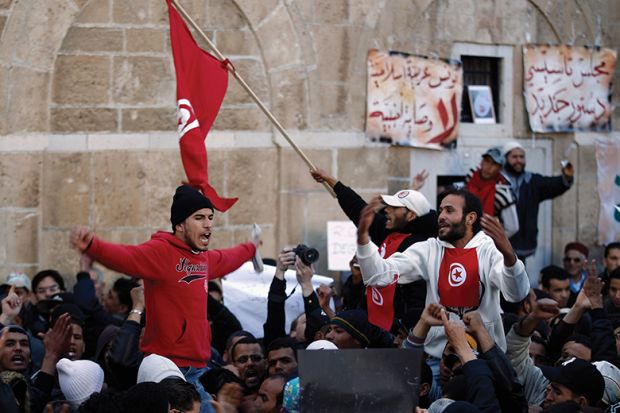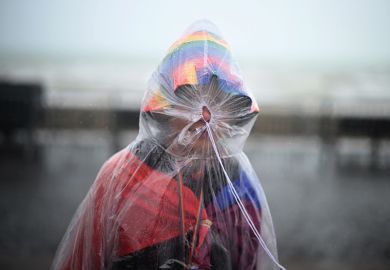Observers of the Arab world are far from agreeing on the causes of the 2011 Arab uprisings and the reasons why most of them failed to achieve their objectives, mainly freedom, justice and dignity. Yet it is still too early to write them off: in 2018-19, more of the same protest erupted in Algeria, Sudan, Egypt, Iraq and Lebanon.
Such protest seems likely to continue for the foreseeable future as the conditions that gave rise to the 2011 uprisings in every country of the Arab world have only worsened. Unemployment increased among a youth bulge; welfare services such as education, health and housing are depleted; and regimes have only strengthened their grip on their populations by importing new surveillance technologies and spreading terror against unarmed civilians and protesters.
Marina and David Ottaway, the authors of A Tale of Four Worlds, are familiar with the Arab political landscape since the 1960s and tell the story of the 2011 protests in four regions: the Levant, the Gulf, Egypt and the Maghreb (although Algeria, Yemen, Iraq and Libya are excluded from consideration). They offer a sound analysis of why protest erupted and, in most countries (with perhaps the exception of Tunisia), failed.
The book describes countries where mild protest erupted and was quickly contained such as those in the Gulf region. These are seen as exceptionally stable, thanks to oil wealth and benevolent monarchs. The new authoritarianism that settled in Egypt with the 2013 coup of General Abdel Fattah al-Sisi against the elected Muslim Brotherhood president, Mohammed Morsi, promises prosperity and stability but delivers none. In Syria, the sectarianisation of the protest precipitated an ongoing civil war and the emergence of the Islamic State. In Iraq, protest has erupted several times, with demonstrations in public squares demanding an end to endemic corruption and failed services. They are met with bullets and soldiers who have been trained by the invading US army since 2003.
There are many causes of the Arab uprisings, for example the collapse of trust between rulers and ruled, repression and socio-economic conditions. The authors offer an alternative explanation, arguing that the real problem is lack of a “state project”, a sense of national identity and purpose. Although they emphasise the importance of “agency” in the uprisings, they think that crowds are politically ineffective except in the short run. This, they believe, explains why initiative and control slipped away from the original protesters to a totally different set of actors.
The Ottaways reach a number of conclusions. In the Maghreb, we can look forward to a slightly brighter future, with the stabilisation of Tunisia and the limited reforms in Morocco. In the Gulf, future challenges include the fact that the original inhabitants of the land are now a minority among an increasingly ethnically and religiously diverse population. The countries are truly multinational states governed by regimes that insist on imagined Arab and Muslim national identities. In Egypt, greater repression has made the country less pluralistic and more polarised, with secularists and Islamists engaged in what appears to be an endless war. In the Levant, and above all in Syria and Iraq, the collapse of the state is beyond redemption.
Unfortunately, the authors fail to acknowledge the interconnectedness of the Arab world. The internet and social media have reignited a common Arab identity no longer based on the old ideologies of Arab nationalism in their Nasserite or Baathist versions. Against this new trend, regimes quickly started promoting local nationalist rhetoric and slogans such as “Saudi Arabia First” and “Jordan First”. While the Ottaways confirm that pan-Arabism is dead, trans-Arab identities and connectivity are the new forces that facilitated the domino effect of the uprisings, helping us to understand how Mohamed Bouazizi, the Tunisian who set himself on fire in the remote town of Sidi Bouzid, triggered protest not only in Tunisia but right across the Arab world.
Madawi Al-Rasheed is visiting professor at the Middle East Centre, London School of Economics, and the editor of Salman’s Legacy: The Dilemmas of a New Era in Saudi Arabia (2018).
A Tale of Four Worlds: The Arab Region after the Uprisings
By Marina and David Ottaway
Hurst, 256pp, £25.00
ISBN 9781787382084
Published 15 August 2019
Register to continue
Why register?
- Registration is free and only takes a moment
- Once registered, you can read 3 articles a month
- Sign up for our newsletter
Subscribe
Or subscribe for unlimited access to:
- Unlimited access to news, views, insights & reviews
- Digital editions
- Digital access to THE’s university and college rankings analysis
Already registered or a current subscriber? Login








